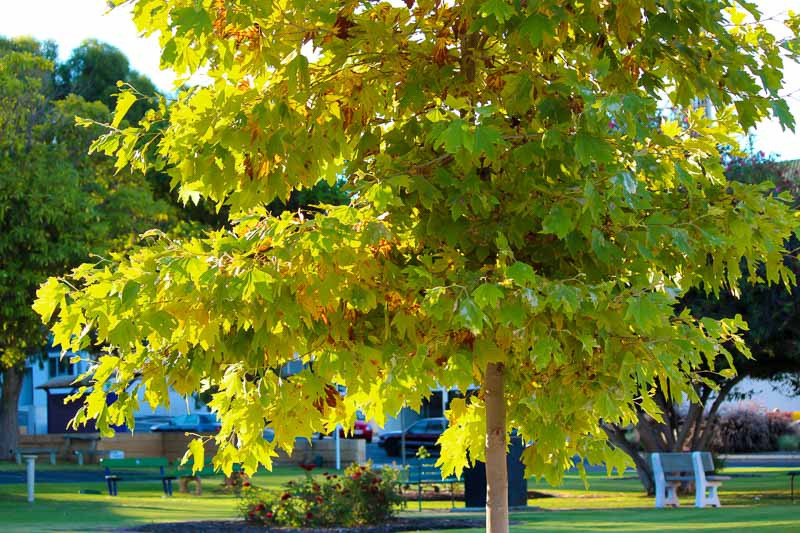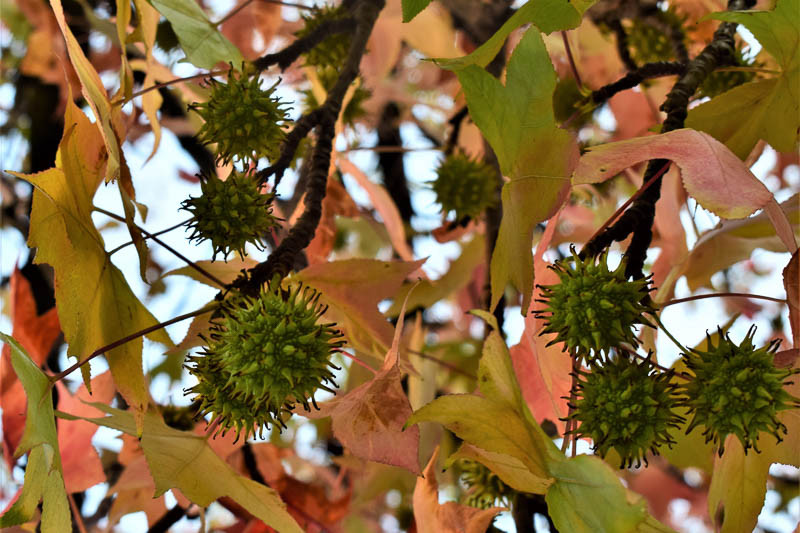American Sycamore, Eastern Sycamore, American Plane Tree, Plane Tree, Buttonwood, Buttonball Tree
Platanus occidentalis, commonly known as the American Sycamore or Western Plane, is a robust, deciduous tree. It’s known for its grandeur, fast growth rate, and distinctive, exfoliating bark. The American sycamore is renowned for its longevity, typically living for at least 200 years, and can potentially reach an impressive lifespan of 500–600 years.
Native: This Sycamore tree is native to the eastern and central regions of the United States, the mountainous areas of northeastern Mexico, and the southernmost part of Ontario.
Plant Type and Habit: The Sycamore is a fast-growing, deciduous tree adorned with a massive trunk and a rounded crown of huge, crooked, horizontal branches. It exhibits a broad, spreading habit with an open, sometimes irregular crown, giving it a majestic appearance.
Size: It’s one of the largest native trees in North America, growing 70-100 feet tall and wide (21-30 meters).
Flowers: Small, inconspicuous flowers appear in rounded clusters in spring. The female flowers are followed by tiny, fuzzy, long-stalked, hanging balls that persist into early winter.
Foliage: The leaves are large, maple-shaped, usually 4-10 inches (10-25 cm) wide, with a vibrant green color turning to a golden brown in fall.
Bark: One of the most striking features of the American Sycamore is the bark, which peels away in patches to reveal a white, tan, or greenish inner bark, creating a mottled appearance.
Hardiness: It’s a hardy tree, adaptable to various soil types, thriving in USDA zones 4-9.
Uses: The Sycamore tree is widely used as a street or shade tree due to its size and ornamental bark. It is also used in reforestation and landscaping projects. The wood is tough and durable, used for furniture, interior trim, and butcher blocks. A majestic and noble tree for plantings along streams, in groupings, or as a single specimen.
Wildlife: Numerous songbirds, such as the Purple Finch, Juncos, American Goldfinch, and Carolina Chickadee, are fond of the seeds. Additionally, the tree provides a habitat for wood-boring insects and leafhoppers.
Deer and Rabbits: Generally resistant to deer and rabbits.
Toxicity: There are no known toxic effects on humans or pets from Platanus occidentalis.
Benefits: The Sycamore tree offers significant environmental benefits, including air purification, carbon sequestration, and soil stabilization. Provides aesthetic value to landscapes with its impressive stature and unique bark.

Growing and caring for a Sycamore Tree can be a rewarding experience due to its majestic presence and environmental benefits.

| Hardiness |
4 - 9 |
|---|---|
| Climate Zones | 1, 1A, 1B, 2, 2A, 2B, 3, 3A, 3B, 4, 5, 6, 7, 8, 9, 10, 11, 12, 13, 14, 15, 16, 17, 18, 19, 20, 21, 22, 23, 24 |
| Plant Type | Trees |
| Plant Family | Platanaceae |
| Common names | American Sycamore, Sycamore |
| Exposure | Full Sun |
| Season of Interest |
Spring (Mid, Late) Summer (Early, Mid, Late) Fall |
| Height |
70' - 100' (21.3m - 30.5m) |
| Spread |
70' - 100' (21.3m - 30.5m) |
| Maintenance | High |
| Water Needs | Average, High |
| Soil Type | Clay, Loam, Sand |
| Soil pH | Acid, Alkaline, Neutral |
| Soil Drainage | Moist but Well-Drained |
| Characteristics | Showy, Fruit & Berries |
| Native Plants | United States, Massachusetts, New York, New Jersey, New Hampshire, Maryland, Connecticut, Maine, Vermont, Rhode Island, Pennsylvania, Delaware, Northeast, Southwest, Midwest, Southeast, Kansas, Wisconsin, Illinois, Nebraska, Michigan, Missouri, Iowa, Indiana, Ohio, Kentucky, Georgia, Alabama, Florida, Arkansas, South Carolina, West Virginia, Mississippi, Louisiana, Virginia, North Carolina, Tennessee, Texas, Oklahoma |
| Tolerance | Deer, Wet Soil |
| Attracts | Birds |
| Garden Uses | Ponds And Streams, Rain Gardens |
| Garden Styles | Prairie and Meadow |
| Hardiness |
4 - 9 |
|---|---|
| Climate Zones | 1, 1A, 1B, 2, 2A, 2B, 3, 3A, 3B, 4, 5, 6, 7, 8, 9, 10, 11, 12, 13, 14, 15, 16, 17, 18, 19, 20, 21, 22, 23, 24 |
| Plant Type | Trees |
| Plant Family | Platanaceae |
| Common names | American Sycamore, Sycamore |
| Exposure | Full Sun |
| Season of Interest |
Spring (Mid, Late) Summer (Early, Mid, Late) Fall |
| Height |
70' - 100' (21.3m - 30.5m) |
| Spread |
70' - 100' (21.3m - 30.5m) |
| Maintenance | High |
| Water Needs | Average, High |
| Soil Type | Clay, Loam, Sand |
| Soil pH | Acid, Alkaline, Neutral |
| Soil Drainage | Moist but Well-Drained |
| Characteristics | Showy, Fruit & Berries |
| Native Plants | United States, Massachusetts, New York, New Jersey, New Hampshire, Maryland, Connecticut, Maine, Vermont, Rhode Island, Pennsylvania, Delaware, Northeast, Southwest, Midwest, Southeast, Kansas, Wisconsin, Illinois, Nebraska, Michigan, Missouri, Iowa, Indiana, Ohio, Kentucky, Georgia, Alabama, Florida, Arkansas, South Carolina, West Virginia, Mississippi, Louisiana, Virginia, North Carolina, Tennessee, Texas, Oklahoma |
| Tolerance | Deer, Wet Soil |
| Attracts | Birds |
| Garden Uses | Ponds And Streams, Rain Gardens |
| Garden Styles | Prairie and Meadow |
How many Platanus occidentalis (American Sycamore) do I need for my garden?
| Plant | Quantity | |
|---|---|---|
| Platanus occidentalis (American Sycamore) | N/A | Buy Plants |
Create a membership account to save your garden designs and to view them on any device.
Becoming a contributing member of Gardenia is easy and can be done in just a few minutes. If you provide us with your name, email address and the payment of a modest $25 annual membership fee, you will become a full member, enabling you to design and save up to 25 of your garden design ideas.
Join now and start creating your dream garden!
Create a membership account to save your garden designs and to view them on any device.
Becoming a contributing member of Gardenia is easy and can be done in just a few minutes. If you provide us with your name, email address and the payment of a modest $25 annual membership fee, you will become a full member, enabling you to design and save up to 25 of your garden design ideas.
Join now and start creating your dream garden!